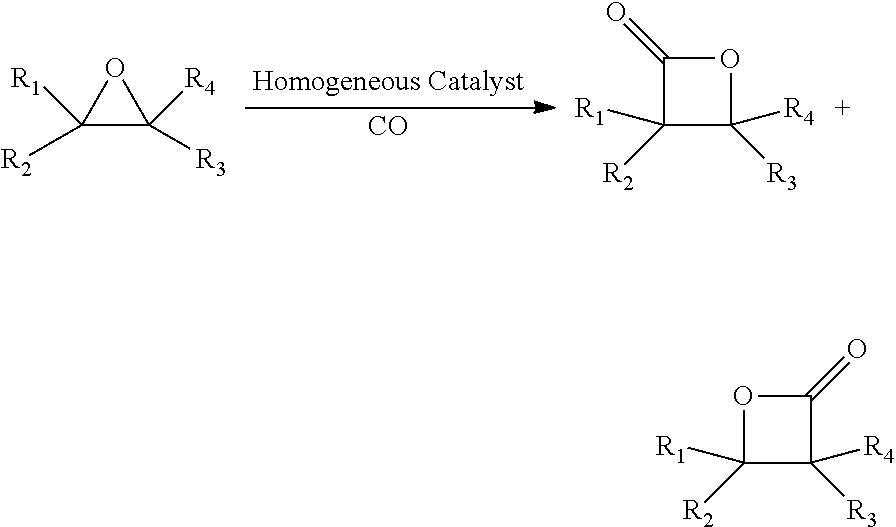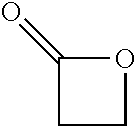Processes for producing beta-lactone and beta-lactone derivatives with heterogenous catalysts
a technology of heterogeneous catalysts and catalysts, which is applied in the direction of catalyst activation/preparation, physical/chemical process catalysts, organic chemistry, etc., can solve the problems of high cost of moving large volumes of solvent through the system, high cost of heating and distillation equipment, and high cost of large volume of solvents. achieve the effect of less carbon footprint and more efficient processes
- Summary
- Abstract
- Description
- Claims
- Application Information
AI Technical Summary
Benefits of technology
Problems solved by technology
Method used
Image
Examples
example 1
eous Catalyst
[0185]The use of ZSM-5 pentasil zeolite (from Conteka) which is impregnated with 20 wt % KOH and calcined at 530° C. for five hours, as a solid support. A dried sample of ZSM-5 (103 g) is charged into a 500 mL 3-neck round bottom flask equipped with an inert gas inlet, a gas outlet, and a scrubber containing aqueous sodium hydroxide solution. A solution containing 143 g n-heptane (99+%; 4] is added to the flask under a dry inert gas atmosphere. The mixture is mixed well by swirling. Solvent is removed using a rotary evaporator at 80° C. and 5-10 mbar pressure.
[0186]A portion of the dried impregnated ZSM-5 thereby obtained is charged into a tubular quartz reactor (1 inch ID, 16 in long) equipped with a thermowell, a 500 mL 3-neck round bottom flask, a heating mantle, an inert gas inlet and a scrubber (containing aqueous sodium hydroxide). The bed of impregnated zeolite ZSM-5 is heated to 850° C. under dry nitrogen (99.999% purity) flow (400 cc / min). After the bed tempera...
example 2
n of Ethylene Epoxide to β-Propiolactone
[0188]
[0189]A 300 mL Parr reactor is dried overnight under vacuum. In a nitrogen glovebox, the reactor is charged with [(CITPP)Al][Co(CO)4] (66 mg, 60 mmol) on a solid support, such as ZSM-5 (1 g), hexamethylbenzene (162 mg, 1.0 mmol), and THF (dried over 4 Å molecular sieves, and freeze, pump, and thaw 3 times), then closed and removed from the glovebox. Ethylene oxide is vacuum transferred to a transfer vessel from EO lecture bottle. The Parr reactor is cooled to −78° C. and high vacuum is applied to the reactor. The vacuum is disconnected from the reactor, and the transfer vessel is connected to the Parr reactor to allow EO to be vacuum transferred from the transfer vessel to the reactor at −78° C. The reaction mixture is warmed to ambient temperature and saturated with CO by pressurizing the reactor with CO to three fourth of the desired CO pressure (e.g. 150 psi), then heated to the desired temperature. After the temperature of reaction m...
example 3
n of Propylene Epoxide to β-Lactone
[0193]
[0194]A representative Reaction Procedure for Carbonylation of Propylene Oxide is as follows:
[0195]A 300 mL Parr reactor is dried overnight under vacuum. In a nitrogen glovebox, the reactor is charged with [(CITPP)Al][Co(CO)4] (66 mg, 60 μmol) on ZSM-5 (4 g) and hexamethylbenzene (81 mg, 0.50 mmol), then closes and removes from the glovebox. Solvent is added via a syringe under N2. The reaction mixture is saturated with CO by pressurizing the reactor with CO to about 15 psi. Propylene oxide (6.3 mL, 90 mmol) is added to the reactor via syringe. The reactor is pressurized with CO to three fourth of the desired CO pressure (e.g. 150 psi), then heated to the desired temperature. After the temperature of reaction mixture reaches the desired temperature, the reactor is pressurized to the desired pressure (e.g. 200 psi). The reaction mixture is agitated for 3 h. The reactor is cooled to 1H NMR in CDCl3.
PUM
| Property | Measurement | Unit |
|---|---|---|
| Percent by mass | aaaaa | aaaaa |
| Percent by mass | aaaaa | aaaaa |
| Percent by mass | aaaaa | aaaaa |
Abstract
Description
Claims
Application Information
 Login to View More
Login to View More - R&D
- Intellectual Property
- Life Sciences
- Materials
- Tech Scout
- Unparalleled Data Quality
- Higher Quality Content
- 60% Fewer Hallucinations
Browse by: Latest US Patents, China's latest patents, Technical Efficacy Thesaurus, Application Domain, Technology Topic, Popular Technical Reports.
© 2025 PatSnap. All rights reserved.Legal|Privacy policy|Modern Slavery Act Transparency Statement|Sitemap|About US| Contact US: help@patsnap.com



